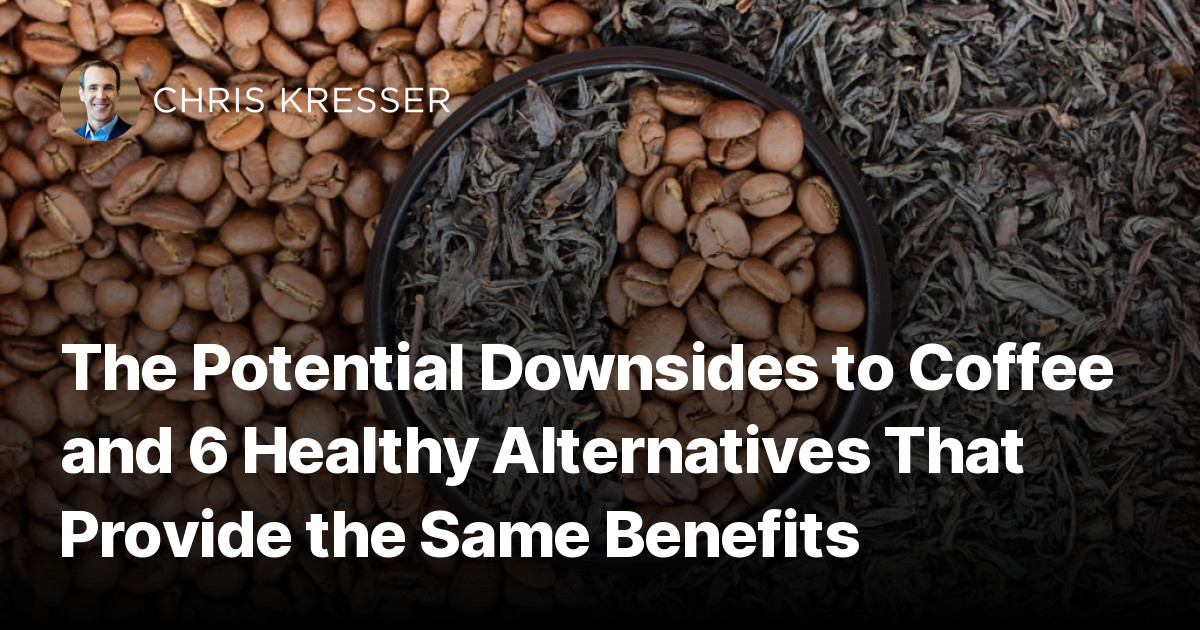
The Potential Downsides to Coffee and 6 Healthy Alternatives That Provide the Same Benefits

|
Listen to this article |
Coffee is one of the most popular beverages worldwide and demonstrates clear health benefits. As Chris discussed in his article on the top five health benefits of coffee, regular coffee consumption reduces the risk of cardiovascular and neurodegenerative diseases and may even offer protective anti-cancer effects. (1, 2, 3, 4, 5) The health benefits of coffee are attributed to an array of natural compounds, including caffeine and polyphenols. (6)
However, coffee isn’t the right fit for everyone. Certain health conditions and stages of life, such as hypothalamic–pituitary–adrenal (HPA) axis dysfunction, autoimmunity, or pregnancy, may necessitate a break from coffee consumption. Read on to learn about six coffee alternatives worth trying that offer similar health benefits.
Potential Downsides of Coffee
Coffee is not an excellent fit for everyone; specific subgroups of people may need to limit their coffee intake or avoid it entirely. These groups include:
- People with acid reflux, gastroesophageal reflux disease (GERD), or gastritis. Many people with acid reflux, GERD, or gastritis anecdotally report that coffee consumption worsens their gastrointestinal symptoms. Early scientific research suggested that coffee induces stomach acid secretion by upregulating the hormone gastrin (7) and relaxes the lower esophageal sphincter, a compact bundle of muscles at the lower end of the esophagus that usually prevents stomach acid from backflowing into the esophagus. (8) Increased stomach acid production induced by coffee may exacerbate stomach inflammation and precipitate reflux. However, it is important to note that the research doesn’t consistently show a relationship between coffee and GERD, specifically. (9) Those with acid reflux, GERD, and gastritis may benefit from removing coffee from their diets, but tolerance of coffee tends to vary individually.
- People on the autoimmune protocol (AIP). The elimination phase of the AIP diet involves removing all nuts and seeds. Nuts and seeds are removed temporarily because they are a common food intolerance. Individuals with autoimmune diseases tend to be more likely to suffer from immunoglobulin G food intolerances than those without autoimmunity. (10) Coffee beans are technically seeds, so people in the elimination phase of the AIP will need to remove coffee, at least temporarily, and may benefit from coffee alternatives.
- People suffering from poor sleep quality and insomnia. It should come as no surprise that caffeinated coffee significantly impacts sleep; the sleep-disrupting effects of caffeinated coffee are attributed to its effects on adenosine metabolism. Adenosine is a neuromodulator that exerts physiological effects by binding onto adenosine receptors throughout the body. Adenosine accumulates over the day, and, when it binds to its receptors, induces somnolence. In the scientific literature, caffeine is referred to as an “adenosine antagonist”; it latches onto adenosine receptors, preventing adenosine from binding. The result is that we don’t feel sleepy after consuming caffeine! (11) Caffeinated coffee, and other caffeinated beverages, can thus interfere with our ability to fall asleep at night and reduce sleep quality. In fact, your sleep quality may be adversely impacted by caffeine even if you can fall asleep quickly. (12) Those individuals looking to improve their sleep may thus be better off removing caffeinated coffee from their diets for a period.
- People with HPA axis dysfunction. People with a dysfunctional HPA axis, which constitutes the body’s stress response system, often benefit from eliminating coffee until they’ve recovered. Coffee increases cortisol and epinephrine, two critical stress response hormones; in those already struggling with elevated stress hormones, coffee may push the HPA axis over the edge. (13) In addition, those who struggle with anxiety may need to avoid coffee since blockage of adenosine receptors by caffeine may stimulate excitatory neurotransmission in the brain, exacerbating neurochemical signaling pathways involved in anxiety. (14)
- Women who are pregnant or breastfeeding. Pregnant women are advised to consume no more than 200 mg of caffeine per day since excess caffeine may negatively impact fetal growth and development. Pregnant women are thus advised to drink no more than one and a half 8-ounce cups of coffee per day. While the research on maternal coffee and caffeine intake and nursing outcomes is scant, breastfeeding women are routinely advised to consume no more than 300 mg of caffeine per day, or about two 8-ounce cups of coffee per day. Many pregnant and breastfeeding women choose to forgo coffee altogether, making them good candidates for coffee alternatives.
6 Healthy Coffee Alternatives
If you fit into one of the categories described above, you may want to swap out your coffee for a coffee alternative. Here are six coffee alternatives sourced from diverse reaches of the globe that offer similar health benefits as coffee, along with delicious flavor.
Chicory or Dandelion Root Coffee
Chicory is a plant that belongs to the Asteraceae or “daisy” family. When roasted, the root has a flavor similar to coffee. Dandelion, another member of the Asteraceae family, also has a root that can be roasted and steeped in water to make a tea with a flavor reminiscent of coffee. Naturally caffeine-free, chicory and dandelion root “coffee” is rich in the prebiotic inulin, which may support the growth of beneficial gut bacteria and aid in healthy bowel movements. (15, 16, 17, 18) Sip Herbals sells a tasty chicory root coffee replacement that includes a touch of carob, the roasted pod of the Ceratonia siliqua tree that has an earthy, chocolate-like taste.
Green and Black Tea
The second most popular beverage after coffee—tea—is an excellent replacement for those who must eschew coffee. Like coffee, tea provides caffeine, albeit in smaller quantities. For example, a single 8-ounce cup of coffee provides approximately 95 mg of caffeine, whereas an 8-ounce cup of green tea provides 30 to 50 mg of caffeine, and 8 ounces of black tea offers around 70 mg of the stimulant.
Alongside its lower caffeine content, green tea contains many bioactive compounds with neuroprotective, anti-inflammatory, cardioprotective, anti-cancer, and oral health-promoting properties. (19, 20, 21, 22) Two prominent bioactive compounds in green tea are L-theanine and epigallocatechin gallate (EGCG). L-theanine, an amino acid analog found naturally in green tea, protects the brain against oxidative stress induced by excess dopamine; interestingly, this means that the L-theanine found in green tea may smooth out the stimulating effects of the caffeine, which are attributed, in part, to dopaminergic neurotransmission. (23, 24) L-theanine has also been found to reduce stress and anxiety. (25)
EGCG, a polyphenol abundant in green tea, regulates inflammatory signaling and tumor cell proliferation, explaining its potential anti-cancer benefits. Green tea catechins, such as EGCG, also increase glutathione S-transferase activity; glutathione S-transferase is an enzyme involved in phase II detoxification, a process by which the body makes toxins more water-soluble so that they can be excreted. (26) The jury is still out as to whether green tea or black tea offers more antioxidant benefits; however, if the caffeine content of the tea is the most critical factor, then green tea, with its lower caffeine content, is the way to go. Pique Tea is an excellent source of green and black tea. Their teas are organic and rigorously screened for mold, mycotoxins, heavy metals, and other common tea contaminants.
Tulsi Tea
Tulsi, also known as “Holy Basil,” is an adaptogen, or an herb that helps the body adapt to stress. (27) Naturally free of caffeine, tulsi has been used in Indian Ayurvedic medicine for millennia to support a balanced response to mental and emotional stressors. Modern-day preclinical studies indicate that Tulsi has neuroprotective effects and may support healthy cognitive function. (28, 29)
Yerba Mate
Yerba mate is a robust, herbaceous tea made from the leaves and twigs of Ilex paraguariensis, a member of the holly family native to South America. Yerba mate contains a respectable dose of caffeine, coming in at 85 mg per cup, so it is not a low-caffeine alternative to coffee. It includes various phytochemicals, including chlorogenic acids, hydroxycinnamic acids, and triterpenic saponins, which may account for its ergogenic and cholesterol-lowering properties. (30) Yerba mate consumption has been found to improve satiety, mood, focus, energy, and concentration. (31)
Mushroom Tea
Mushroom teas, which usually consist of a blend of medicinal mushrooms such as Chaga, reishi, and cordyceps, are booming in popularity. One potential reason for the popularity of medicinal mushroom tea is the benefit such teas offer for focus, attention, and overall cognition without causing the jitters associated with caffeine.
How do mushrooms boost energy, focus, and other aspects of cognition? Many medicinal mushrooms are nootropics, or neurologically active substances that directly or indirectly enhance cognitive function while exhibiting few side effects and little to no toxicity. Some of these same mushrooms also offer long-term neuroprotective benefits, similar to the neuroprotective effects of coffee. Lion’s mane mushroom is notable for its nootropic benefits; it contains phytochemicals called erinacines that stimulate nerve growth factor, a compound crucial for maintaining healthy brain structure and function. (32) Lion’s mane may support healthy brain aging and protect against and even treat neurodegenerative disorders, such as Alzheimer’s disease (33, 34, 35). Cordyceps also offers neuroprotective benefits and has the added benefit of modulating the immune system. (36, 37)
Many medicinal mushrooms also offer immune system-regulating and chemoprotective benefits. For example, in preclinical research, Chaga mushroom has been shown to suppress cancer progression by inhibiting tumor agglomeration and vascularization. (38) If you want to give mushroom teas a try as a replacement for coffee, Four Sigmatic is a great option.
Brewed Cacao
Last but certainly not least, brewed cacao is growing in popularity as an alternative to coffee. Brewed cacao comes from the pod of Theobroma cacao, the same plant we use to make dark chocolate, and has the deep, rich aroma and flavor of chocolate. However, unlike a dark chocolate bar, it contains only 10 calories per cup.
The potential health benefits of brewed cacao are many. Brewed cacao contains theobromine, a phytochemical from the methylxanthine family, the same group of compounds to which caffeine belongs. (39) Like caffeine, theobromine crosses the blood–brain barrier and is an adenosine antagonist, inhibiting adenosine binding and promoting wakefulness. (40) However, its effects are longer-lasting than those of caffeine, and it tends to be less stimulating than its sister compound. (41)
Cacao also contains flavanols, which are compounds with antioxidant properties that support the cardiovascular and cerebrovascular (relating to the brain and its blood vessels) systems. Animal studies suggest that theobromine increases brain-derived neurotrophic factor, a key molecule involved in neuroplasticity, learning, and memory. (42, 43) A randomized, placebo-controlled crossover experiment found that consuming brewed cacao enhances aspects of attention, improving performance on cognitive tasks. (44) A side benefit is that brewed cacao also tastes pretty fantastic! If you’re interested in trying brewed cacao as an alternative to coffee, then Crio Bru is one option to consider; it contains just 10 mg of caffeine per 8-ounce serving and 358 mg of theobromine.
If coffee isn’t an option for you, don’t despair. There’s a world of other beverages out there with great taste and numerous health benefits that you can try instead. Who knows, you may even find that one of these “coffee alternatives” becomes your new favorite beverage!






